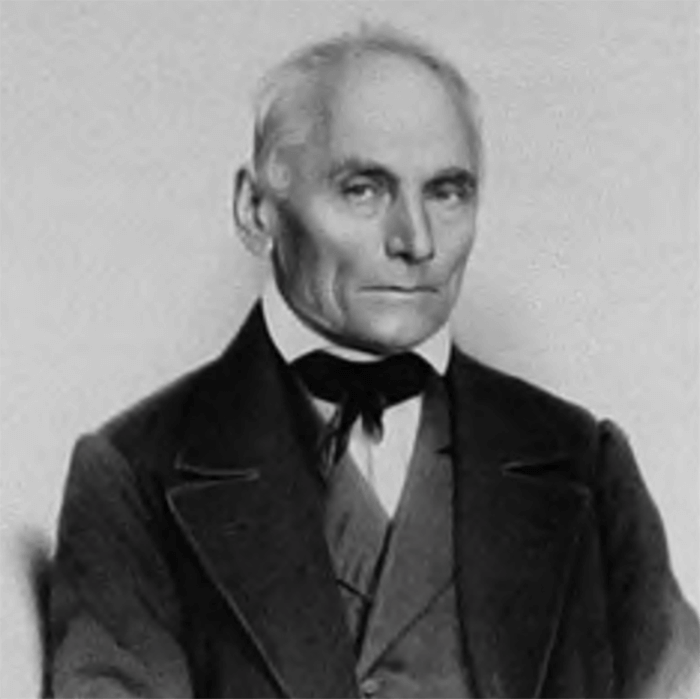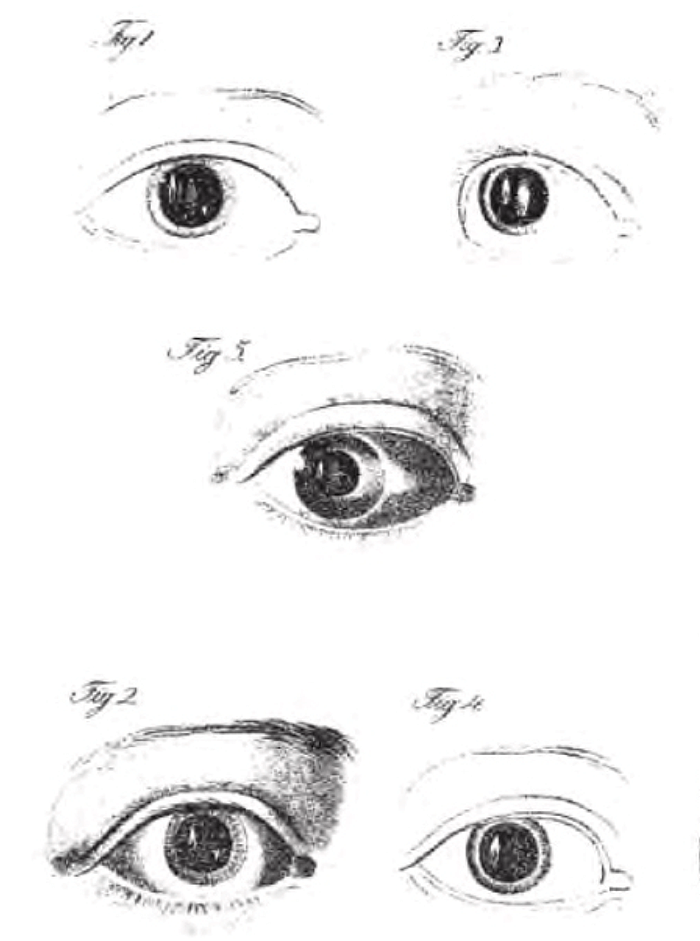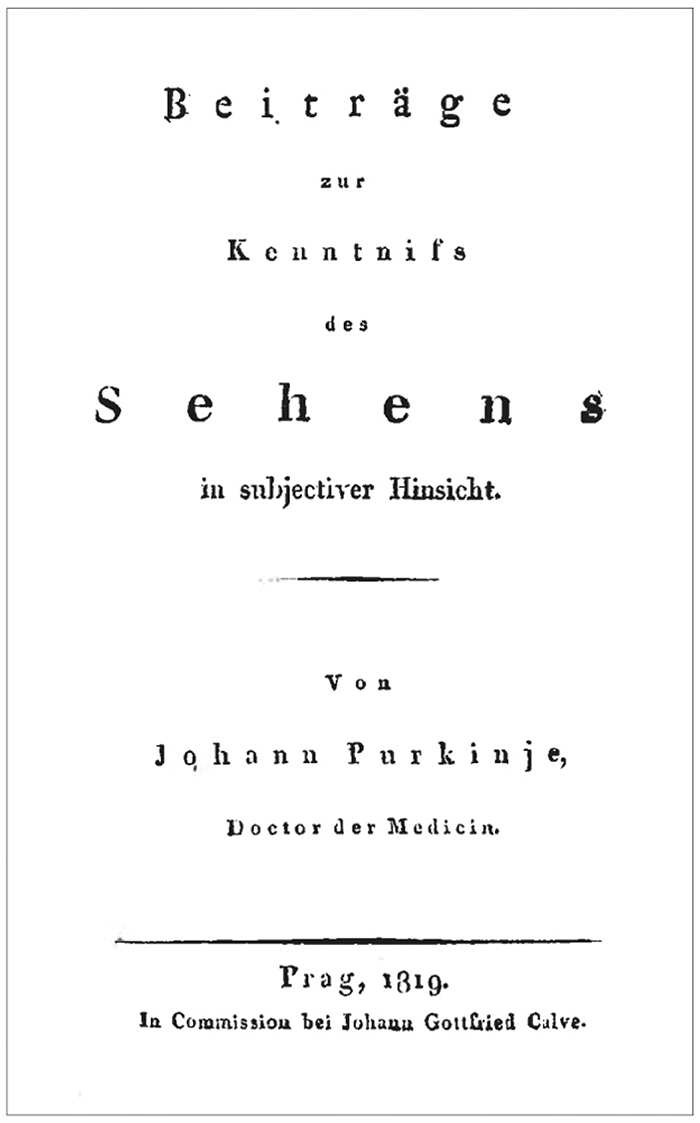
Although eye physiology was never one of Purkinje’s main interests, through coincidence it ended up playing a key role in his professional development. It could even be argued that without it, his remarkable scientific career may never have occurred. So what happened?
Jan Evangelista Purkyně, also known as Purkinje, a Czech anatomist and experimental physiologist, graduated from Charles University, Prague, Czechia, with a degree in medicine in 1818. A year later, he received his PhD entitled “Contributions to the Knowledge of Vision in Its Subjective Aspect,” (1) which described entoptic phenomena. Self-examining, he concluded that these phenomena resulted only from the brain’s activity and connection to the eye, with external stimuli having no influence. He sent this work to the German poet Johann Wolfgang Goethe who was keenly interested in vision, having proposed early concepts of color vision in 1810 (2, 3). The work interested Goethe, and the two actively corresponded about it.
For Purkinje, acquiring a university position within the Habsburg monarchy proved difficult. Being Czech, he often faced rejection as policies of the time encouraged the promotion of Austrian citizens. However, through strong support from Goethe and his friend, the famous geographer Alexander von Humboldt, Purkinje was eventually appointed Professor of Physiology and Pathology at the University of Breslau, Germany (presently Wrocław, Poland) in 1823. That same year, he wrote his second work on eye and vision physiology entitled “Physiological Examination of the Visual Organ and of the Cutaneous System,” (4).
Here, he stated the importance of physiological research as well as studying eye anatomy and physiology, and the physiology of the skin. He also presented the first visualization of human living fundus: “I also had a chance to see the interior of the eye where the vitreous body is located when, wearing myopic lenses, with candle light coming from far back, I examined the eye of a dog in order to learn about the nature of the shine which often marvelously emanates from the eyes of dogs and cats. […] I constructed an artificial eye, which I filled with water, either clear or turbid to some degree, and the light shining through revealed both the background and the nature of the fluid. Thus, from now on practically no membrane or liquid content of the eye will escape the properly reflected light or the scrutinizing eye, and if practitioners, spurring the painstaking inquiries of physiologists, will not disdain or fear this [method], they will find it useful in ocular diagnosis,” (4).

The publication was released in Latin, even though most scientific papers at that time were published in vernacular languages, in small numbers and only in local editions. These factors likely influenced the non-recognition of this work by the majority of the research community. Even today, finding translations of the publication is hard. Because of this, in 2013, we prepared translations into Polish (5) and English (6), which are both freely available. In the same work, Purkinje described images of the object produced by reflections from the surface of the anterior and posterior cornea surfaces, and the anterior and posterior lens surfaces presently known as Purkinje or Purkinje-Sanson images (see Figure 3).
Purkinje’s research was ingenious, contributing to several organs within the human body. His work is remembered by many eponyms, including Purkinje conduction, Purkinje’s cells I, Purkinje’s cells II, Purkinje’s fibers, Purkinje’s law of vertigo, Purkinje’s layer, Purkinje’s network, Purkinje’s space, and Purkinje’s vesicle. He introduced the scientific terms “protoplasm” and “plasma,” and was the first to provide a general concept of the stomach’s role in food digestion, use the microtome, and recognize the individualistic nature of fingerprints (7, 8).
Purkinje retired in 1850, moving to Prague where he became a professor of physiology, opened the Institute of Physiology and also became engaged in promotion of Czech culture.

Andrzej Grzybowski is a Professor of Ophthalmology and Chair of Department of Ophthalmology, University of Warmia and Mazury, Olsztyn, Poland, and Head of Institute for Research in Ophthalmology, Foundation for Ophthalmology Development, Poznań, Poland.
He is also an expert in the history of ophthalmology, with over 100 peer-reviewed articles published in this area. He is a member of AAO Museum of Vision’s Program Committee, curator of ESCRS Archive, founder of history section at EVER. He is the president of the Polish Society for History and Philosophy of Medicine; Editor-in-Chief of Archives of History and Philosophy of Medicine, and Historia Ophthalmologica Internationalis, the only journal devoted solely to the history of ophthalmology
References
- JE Purkyně, “Beiträge zur Kenntniss des Sehens in subjectiver Hinsicht,” 1st edition, 1. Calve: 1819.
- J Goethe, “Zur Farbenlehre,” 1st edition, 1. Tübingen: J.G. Cotta: 1810.
- J Goethe, “Theory of Colours: Translated from the German; with Notes by Charles Lock Eastlake, R.A., F.R.S.,” 1st edition, 1. London: John Murray: 1840.
- JE Purkyně, “Commentatio de examine physiologico organi visus et systematis cutanei,” 1st edition, 1. Vratislaviae: Typis Universitatis: 1823.
- JE Purkyně, “Rozprawa o badaniu fizjologicznym organu wzroku. Archiwum (przekład zbiorowy pod redakcją A. Grzybowskiego),” Arch Hist Filoz Med, 76, 16 (2013).
- JE Purkyně, “Dissertation on Physical Examination of the Organ of Sight (collective translation edited by A. Grzybowski),” Arch Hist Filoz Med, 76, 34 (2013).
- A Grzybowski, K Pietrzak, “Jan Evangelista Purkynje (1787-1869),” J Neurol, 261, 2048 (2014). PMID: 24240481.
- A Grzybowski, K Pietrzak, “Jan Evangelista Purkynje (1787-1869): first to describe fingerprints,” Clin Dermatol, 33, 117 (2015). PMID: 25530005.
